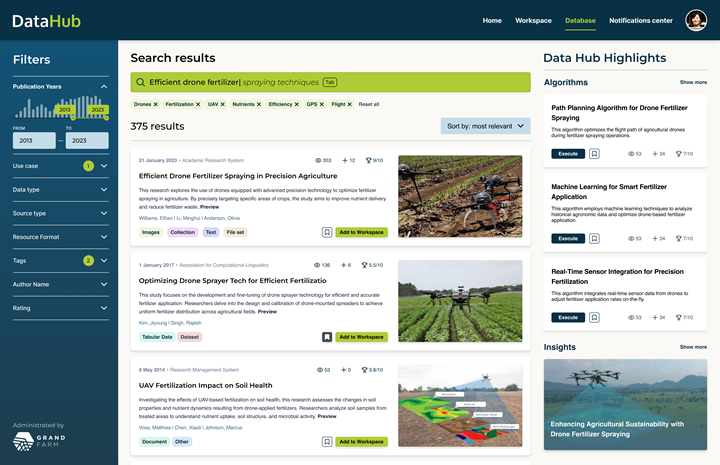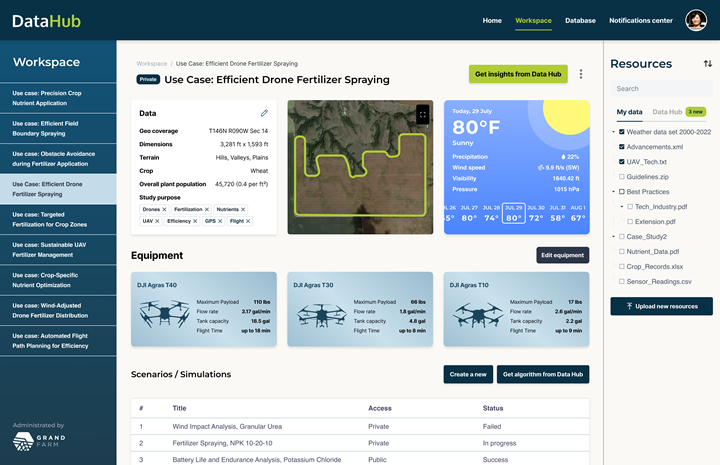The Data Hub allows researchers, innovators, and industry professionals to access publicly available data to enable data-driven decisions and increase profitability for farmers by breaking down data silos.
 Addressing the Challenges of Data Silos in Agriculture
Addressing the Challenges of Data Silos in Agriculture

Q&A with | Intellias
Tell us about your product and what you feel sets it apart from similar products.
The Data Hub allows researchers, innovators, and industry professionals to access publicly available data to enable data-driven decisions and increase profitability for farmers by breaking down data silos.
It is an innovative platform that addresses a critical challenge faced by the agricultural community — the existence of data silos. Since digital solutions offered to farmers are usually one-size-fits-all models, they don’t work as expected. Each ranch or farm environment, however, is unique and demands a customized approach. Our Data Hub is what provides this required customization.
From all agriculture public information, the Data Hub helps to find, store, and consolidate the most relevant data and turn it into an effective model for a particular farm or ranch.
Our system is unique and has no equivalents. It's a fourth-generation farm management system. Currently, on the market, there are third-generation farm management systems that collect data and assist farmers. However, they lack the components of AI and digital twin.
We integrate AI and digital twin into existing systems, basing our architecture on an AI-first approach. We emphasize building the system with AI and digital twin as core functionalities, rather than just adding AI as an extension.
As a result, our system will have many more capabilities compared to systems where AI is simply added as an add-on.

The Data Hub allows researchers, innovators, and industry professionals to access publicly available data to enable data-driven decisions and increase profitability for farmers by breaking down data silos.
Tell us about the R&D behind this product. Who is this product designed for? What problem is it solving?
The R&D behind the Data Hub is a collaborative effort between Intellias, a global technology innovator for top-tier organizations and Fortune 500 companies, and Grand Farm, a network of growers and technologists aiming to solve problems in agriculture through AgTech. Together, we've focused on creating an open-source data storage interface to break down data silos in agriculture.
The need originated from Grand Farm, and they provided the high-level concept of this system. Intellias contribution, after several workshops, included analyzing and expanding their vision in terms of functionality and technical implementation. They brought a valuable perspective that we were able to incorporate into the real system. We introduced components they hadn't considered, including multi-tenant setup, for example.
During the workshops, we supplemented the overall system vision and accounted for all non-functional requirements. This gave us a better understanding of how to build the platform, as we were responsible for its complete technical implementation, including designing the architecture and all components.
There were certain constraints due to the intention of partnering with Microsoft, which required us to build out a system infrastructure in Azure. Additionally, Grand Farm already had partners for hardware collaboration. We had to thoroughly study their offerings for devices to build our platform within those requirements.
Intellias took all of this into account, enhancing the platform both in terms of functionality and technically in relation to the cloud infrastructure. We went through the entire process from architecture development to component determination. We also considered the future evolution of this system and the possibility of integrating new components.
Our platform is designed for farmers, ranchers, technologists, researchers, and innovators in the agriculture industry to effectively use and combine data for decision-making. The Data Hub provides access to publicly available data that can be used to build models and solutions for tasks such as adjusting spraying speed based on wind conditions, identifying weeds from crops, and other agricultural jobs. The solution aims to improve processes and overall decision-making that, in turn, will lead to higher profits and streamlined operations.
Give us an idea on the installation process.
Since the Data Hub collects and analyzes data from agricultural sensors, it consists of two main parts: hardware and software.
The hardware part is Grand Farm’s responsibility, which includes installing necessary sensors on fields. Once the sensors are installed, they are connected to our cloud system, which will handle data collection and analysis, as well as provide the ability to use this data for various purposes. The Intellias team manages the entire software part. Our engineers will be on-site to connect external controllers, set up the system on the cloud, and perform initial configuration.
The first stage of installation is planned for Grand Farm, and after successful implementation, we plan to expand it among other farms. Our cloud system is multi-tenant, so it will be able to connect various farmers and companies.

Our system is unique and has no equivalents. It's a fourth-generation farm management system. Currently, on the market, there are third-generation farm management systems that collect data and assist farmers. However, they lack the components of AI and digital twin.
How is your company setup to support the users of your products.
Intellias is developing the Data Hub specifically with and for Grand Farm. Thus, we will provide them with all the necessary technical support. As soon as Grand Farm is ready to expand the platform and connect new users, the Data Hub project package will include support as well.
What feedback have you received from the field? Can you share a use case and the results?
The Data Hub has already been showcased at several events and has been warmly received by farmers. There is a high demand for such solutions in agriculture, and there is significant interest and support from the US government, which propels the development of the industry.
The need for high-tech solutions is crucial, and it's important for farmers to understand this. It's also essential for the government to recognize the importance of allocating funds for the digitalization programs of farming enterprises.
Opting for the Data Hub is a smart choice for each farmer, as digitalization and data-driven solutions empower them to optimize operations, improve yields, reduce costs, and contribute to sustainable and environmentally responsible agriculture practices. Access to real-time data and analytics enables farmers to make informed decisions about planting, irrigation, pest control, and harvesting. This can lead to higher productivity and profitability.
The content & opinions in this article are the author’s and do not necessarily represent the views of AgriTechTomorrow
Comments (0)
This post does not have any comments. Be the first to leave a comment below.
Featured Product

